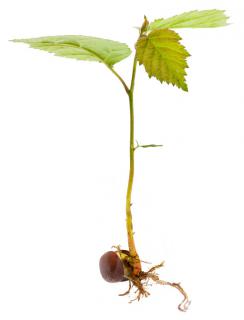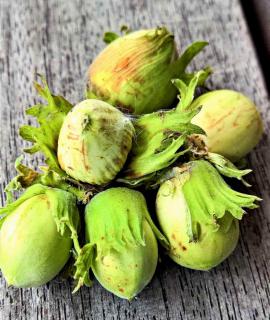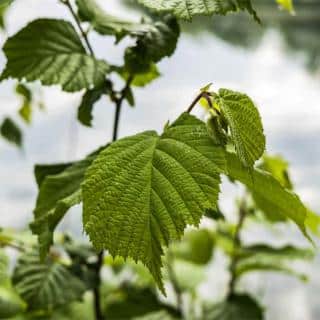

Hazel is a fruit shrub that is sought after for its delicious green or blond hazelnuts.
Top Hazel facts, a short list
Name – Corylus avellana
Family – Betulaceae
Type – shrub
Height – 13 to 20 feet (4 to 6 meters)
Exposure – full sun
Soil – ordinary, rather light
Foliage – deciduous
Flowering – February to April
Harvest – Fall
 It is preferable to plant your hazel in fall to promote root development before winter.
It is preferable to plant your hazel in fall to promote root development before winter.
But you can also plant it in any other season of the year, as long as you avoid high temperatures in summer and frost spells in winter.
It is critical that you plant 2 different varieties together to ensure fertilization and fruit-bearing. Check when purchasing your hazelnut trees that they belong to different species.
Hazel, when well settled in, is a shrub that is easy to care for. Regular pruning will increase the harvest.
The very first pruning is performed upon planting, it is a structural pruning that will select the branches that will become structural branches for the following years.
After that, don’t prune at all for several years so as to give the hazel time to grow.
The second pruning is best done after more or less 5 years, in winter, and keeping the hazel small will increase the harvest.
If you wish to cut the tree back drastically, or prune the tree severely to even out the branches, never do it before the blooming.
 The hazelnuts are ready to be harvested when the fruit detaches from the branch and falls to the ground.
The hazelnuts are ready to be harvested when the fruit detaches from the branch and falls to the ground.
It’s also possible to eat the hazelnuts when still green, but you must eat them immediately because they don’t keep at all.
Their taste is softer and sometimes tart.
Shells are softer and are sometimes easier to slice open with a knife and board than using a nutcracker at this unripe stage.
The most important to keep your hazelnuts over an extended period is to ensure they ripen on the tree until they’re ready.
The hazelnut weevil or Curculio nucum enters the hazelnut and eats it up entirely.
That makes for quite a bad surprise when you realize your hazelnut is hollow!
This is due to Septoria. Septoria is a leaf spot fungus. Hazel is one of the septoria plant hosts.
 Hazel cannot be planted alone because it needs another hazel to produce hazelnuts.
Hazel cannot be planted alone because it needs another hazel to produce hazelnuts.
So set it up in a shrub bed, or add it to your hedge, that will make your hedge even more ornamental and especially, productive!
Hazelnuts are always harvested in fall.
Even if the hazelnuts themselves are the prime appeal of this large shrub, it also has a definite ornamental value thanks to its delicate and colorful leaves.
Read also:
Remove suckers that grow from the base often.